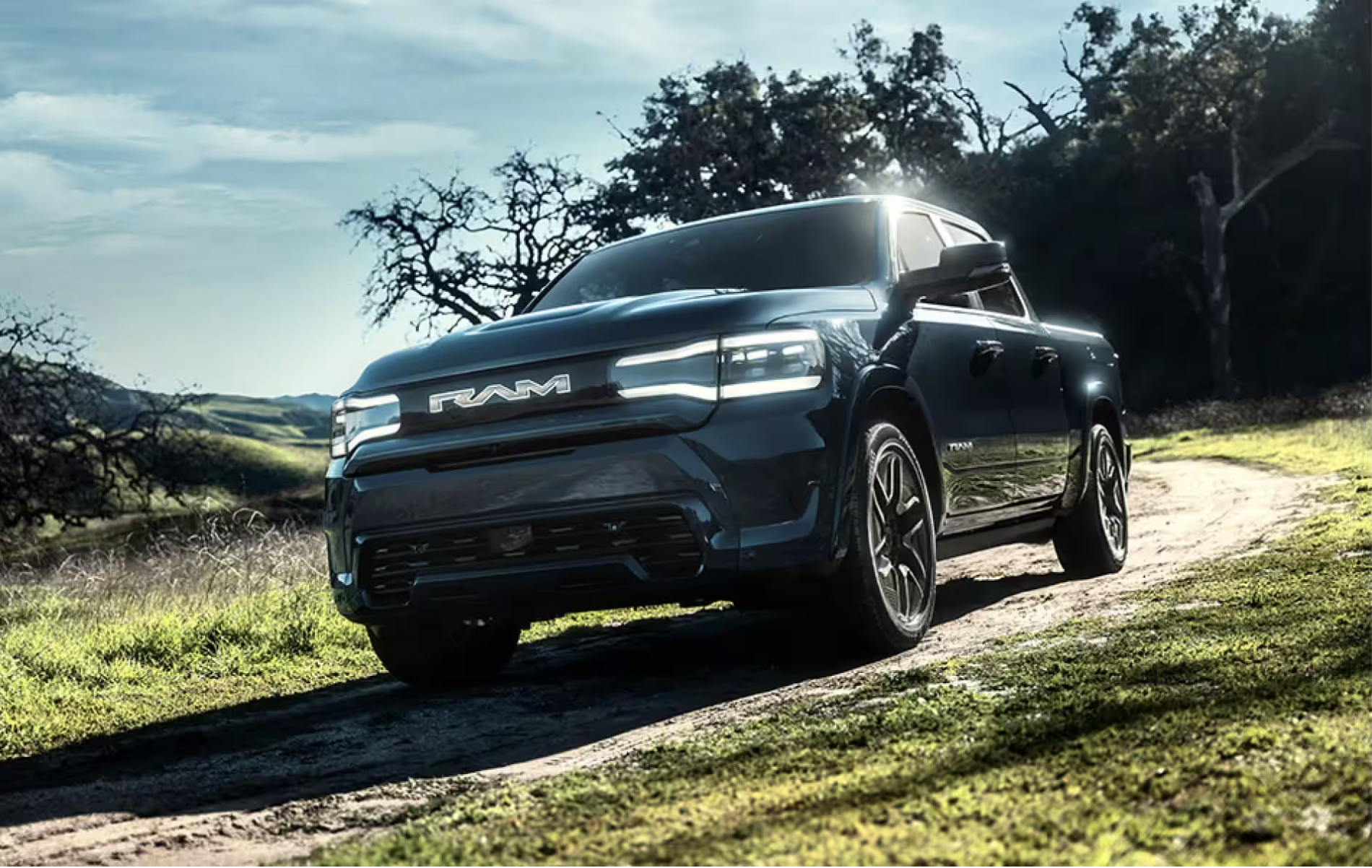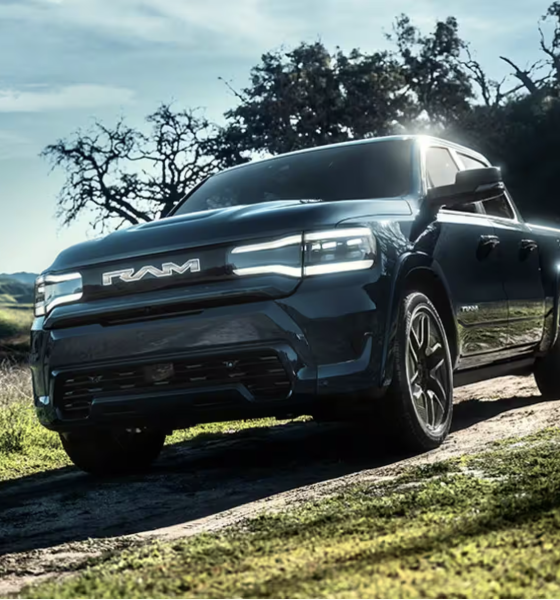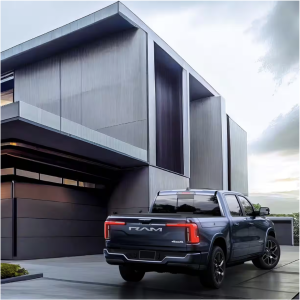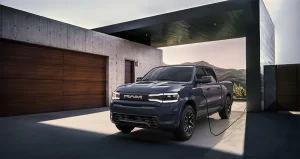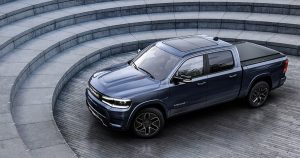RAM has promised big things for its upcoming electric pickup truck, the RAM 1500 REV, though specifications have yet to be released.
Superior range, payload, towing, and charge time; that was the message from RAM when it revealed the name of its first production electric truck, the RAM 1500 REV. This message was echoed in RAM’s Super Bowl commercial that poked fun at “Premature Electrification” (PE) concerns. But without releasing the specifications of its upcoming truck, it remains unclear if the historic American truck can achieve its new herculean task.
RAM has yet to release any information about the RAM 1500 REV, other than its design and release date of “late 2024,” shown in its first-ever Super Bowl commercial. However, looking at the current competition, you can get a good idea of what specs RAM is aiming for.
One of the most critical factors a consumer will look at when buying an EV is the vehicle’s range, so it is no wonder RAM is promising to lead in the category. To achieve this and upset the current range leader in electric pickups, the Rivian R1T, the RAM 1500 REV would need to be able to go more than 328 miles on a single charge; no small task for Stellantis’ first EV in the United States.
Second, if the REV is going to have a superior payload, it will need to put up numbers almost equal to the current gas variant RAM. The Ford F150 Lightning leads electric trucks, having a payload of 2,235 pounds, while the gas-powered RAM 1500 has capacity for only 100 pounds more.
Towing, a massive challenge for any electric truck, could be a particularly difficult challenge for Stellantis engineers if their truck is to be a leader in the segment. While the Ford and Rivian trucks have towing capacities of 10,000 and 11,000 pounds, neither has been able to do so while towing for any considerable distance, a concern that is even addressed in RAM’s own Super Bowl ad. From the testing done by various sources on both the Lightning and the R1T, anything more than 100-120 miles of range while towing could make the 1500 REV a leader in its class.
As if these three tasks weren’t enough, RAM is promising to be a new leader in charge time, a crown that will certainly need to be battled for thanks to Ford’s impressive 30-40 minute 10-80% charge time.
This leads us to the question; are these achievements remotely possible? There are a couple of reasons to believe they are.
- Credit: RAM Trucks
- Credit: RAM Trucks
- Credit: RAM Trucks
- Credit: RAM Trucks
First, suppose RAM can build its first EV on an 800/900-volt architecture. In that case, the drivetrain’s efficiency and charging time could improve dramatically, allowing the 1500 REV to hit many of the targets listed above. This is especially the case compared to the 400-volt architecture used within the current electric trucks on the market.
Second, if RAM can source higher efficiency motors, it may be able to circumvent issues of range, though it may face problems regarding power to move over 11,000 pounds when towing.
Third and potentially the most likely, RAM could opt to fit a gargantuan battery into its first electric truck. With a massive battery pack of over 150 kWh, the 1500 REV would benefit from increased range and increased power thanks to the battery’s ability to meet higher power needs. Though, with such a massive pack, the RAM 1500 REV would suffer in the weight department, potentially decreasing its payload and towing capabilities.
Whether RAM achieves its design goals or not, the added competition in the electric vehicle market is always welcome. Though RAM isn’t introducing its first EV as quickly as many would have hoped, with such high goals, it may be worth waiting for. Though with competition on the horizon, Stellantis will need to work quickly if it hopes not to be left behind.
What do you think of the article? Do you have any comments, questions, or concerns? Shoot me an email at william@teslarati.com. You can also reach me on Twitter @WilliamWritin. If you have news tips, email us at tips@teslarati.com!

Elon Musk
Elon Musk confirms xAI’s purchase of five 380 MW natural gas turbines
The deal, which was confirmed by Musk on X, highlights xAI’s effort to aggressively scale its operations.

xAI, Elon Musk’s artificial intelligence startup, has purchased five additional 380 MW natural gas turbines from South Korea’s Doosan Enerbility to power its growing supercomputer clusters.
The deal, which was confirmed by Musk on X, highlights xAI’s effort to aggressively scale its operations.
xAI’s turbine deal details
News of xAI’s new turbines was shared on social media platform X, with user @SemiAnalysis_ stating that the turbines were produced by South Korea’s Doosan Enerbility. As noted in an Asian Business Daily report, Doosan Enerbility announced last October that it signed a contract to supply two 380 MW gas turbines for a major U.S. tech company. Doosan later noted in December that it secured an order for three more 380 MW gas turbines.
As per the X user, the gas turbines would power an additional 600,000+ GB200 NVL72 equivalent size cluster. This should make xAI’s facilities among the largest in the world. In a reply, Elon Musk confirmed that xAI did purchase the turbines. “True,” Musk wrote in a post on X.
xAI’s ambitions
Recent reports have indicated that xAI closed an upsized $20 billion Series E funding round, exceeding the initial $15 billion target to fuel rapid infrastructure scaling and AI product development. The funding, as per the AI startup, “will accelerate our world-leading infrastructure buildout, enable the rapid development and deployment of transformative AI products.”
The company also teased the rollout of its upcoming frontier AI model. “Looking ahead, Grok 5 is currently in training, and we are focused on launching innovative new consumer and enterprise products that harness the power of Grok, Colossus, and 𝕏 to transform how we live, work, and play,” xAI wrote in a post on its website.
Elon Musk
Elon Musk’s xAI closes upsized $20B Series E funding round
xAI announced the investment round in a post on its official website.

xAI has closed an upsized $20 billion Series E funding round, exceeding the initial $15 billion target to fuel rapid infrastructure scaling and AI product development.
xAI announced the investment round in a post on its official website.
A $20 billion Series E round
As noted by the artificial intelligence startup in its post, the Series E funding round attracted a diverse group of investors, including Valor Equity Partners, Stepstone Group, Fidelity Management & Research Company, Qatar Investment Authority, MGX, and Baron Capital Group, among others.
Strategic partners NVIDIA and Cisco Investments also continued support for building the world’s largest GPU clusters.
As xAI stated, “This financing will accelerate our world-leading infrastructure buildout, enable the rapid development and deployment of transformative AI products reaching billions of users, and fuel groundbreaking research advancing xAI’s core mission: Understanding the Universe.”
xAI’s core mission
Th Series E funding builds on xAI’s previous rounds, powering Grok advancements and massive compute expansions like the Memphis supercluster. The upsized demand reflects growing recognition of xAI’s potential in frontier AI.
xAI also highlighted several of its breakthroughs in 2025, from the buildout of Colossus I and II, which ended with over 1 million H100 GPU equivalents, and the rollout of the Grok 4 Series, Grok Voice, and Grok Imagine, among others. The company also confirmed that work is already underway to train the flagship large language model’s next iteration, Grok 5.
“Looking ahead, Grok 5 is currently in training, and we are focused on launching innovative new consumer and enterprise products that harness the power of Grok, Colossus, and 𝕏 to transform how we live, work, and play,” xAI wrote.
Investor's Corner
Tesla gets price target bump, citing growing lead in self-driving

Tesla (NASDAQ: TSLA) stock received a price target update from Pierre Ferragu of Wall Street firm New Street Research, citing the company’s growing lead in self-driving and autonomy.
On Tuesday, Ferragu bumped his price target from $520 to $600, stating that the consensus from the Consumer Electronics Show in Las Vegas was that Tesla’s lead in autonomy has been sustained, is growing, and sits at a multiple-year lead over its competitors.
CES 2026 validates Tesla’s FSD strategy, but there’s a big lag for rivals: analyst
“The signal from Vegas is loud and clear,” the analyst writes. “The industry isn’t catching up to Tesla; it is actively validating Tesla’s strategy…just with a 12-year lag.”
The note shows that the company’s prowess in vehicle autonomy is being solidified by lagging competitors that claim to have the best method. The only problem is that Tesla’s Vision-based approach, which it adopted back in 2022 with the Model 3 and Model Y initially, has been proven to be more effective than competitors’ approach, which utilizes other technology, such as LiDAR and sensors.
Currently, Tesla shares are sitting at around $433, as the company’s stock price closed at $432.96 on Tuesday afternoon.
Ferragu’s consensus on Tesla shares echoes that of other Wall Street analysts who are bullish on the company’s stock and position within the AI, autonomy, and robotics sector.
Dan Ives of Wedbush wrote in a note in mid-December that he anticipates Tesla having a massive 2026, and could reach a $3 trillion valuation this year, especially with the “AI chapter” taking hold of the narrative at the company.
Ives also said that the big step in the right direction for Tesla will be initiating production of the Cybercab, as well as expanding on the Robotaxi program through the next 12 months:
“…as full-scale volume production begins with the autonomous and robotics roadmap…The company has started to test the all-important Cybercab in Austin over the past few weeks, which is an incremental step towards launching in 2026 with important volume production of Cybercabs starting in April/May, which remains the golden goose in unlocking TSLA’s AI valuation.”
Tesla analyst breaks down delivery report: ‘A step in the right direction’
Tesla has transitioned from an automaker to a full-fledged AI company, and its Robotaxi and Cybercab programs, fueled by the Full Self-Driving suite, are leading the charge moving forward. In 2026, there are major goals the company has outlined. The first is removing Safety Drivers from vehicles in Austin, Texas, one of the areas where it operates a ride-hailing service within the U.S.
Ultimately, Tesla will aim to launch a Level 5 autonomy suite to the public in the coming years.
